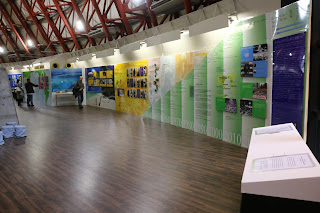 |
| The Outer Appearance of the Daigo Fukuryu Maru Exhibition Hall |
The Daigo Fukuryu Maru (No.5 Lucky Dragon) Exhibition Hall in Tokyo’s Koto City reopened to the general public on April 2 after a nine-month long renovation.
The museum was originally built by the Tokyo Metropolitan Government in 1976, with the aim in mind that the tragedies by the hydrogen bomb test would not be repeated.
During the renovation, lights inside the structure were all replaced with LEDs, and its roof and floor were refitted. A video of a survivor’s interview was newly added to a list of materials being shown. It can be watched on a TV screen. Chinese and Korean languages are also used in part offering the general information on top of the Japanese and English versions.
First and foremost, coming into the view, is the actual 140-ton tuna fishing boat that was exposed to the radioactive fallout from the U.S. hydrogen bomb test at the Bikini Atoll of the Marshall Islands in the western Pacific on March 1, 1954. The boat was then operating outside the exclusive zone set by the United States, but the explosion was far more powerful than had been expected, causing widespread damage to not only hundreds of fishing boats in operation but also those living in the nearby small islands.
 |
| The Front View of the Daigo Fukuryu Maru |
 |
| The End View |
Two weeks later, the Daigo Fukuryu Maru returned to its home in Japan and all 23 crew members aboard were quickly hospitalized for treatment and diagnosed as having acute radiation syndrome.
One of them, Aikichi Kuboyama, the chief radio operator, died six months later. A monument was later erected in his memory outside the building, with his last saying inscribed in it. It says: "I hope I will be the last person to die from an A-and H- bomb."
 |
| The Stone Monument that Aikichi Kuboyama's Message is Inscribed |
At present, four of them are still alive, while the remaining 19 died.
Two years later after its return, the fishing boat was declared free of residual radiation in 1956.
Some of the panels inside represent a timeline that shows pictures of different events from the very first day to the present as well as some explanations about them.
Two years later after its return, the fishing boat was declared free of residual radiation in 1956.
Some of the panels inside represent a timeline that shows pictures of different events from the very first day to the present as well as some explanations about them.
 |
| The Inside the Museum |
A glass vessel containing "radioactive fallout" collected from the deck of the affected boat is also on display. The fallout was analyzed by a group of scientists from the Shizuoka University.
 |
| Radioactive Fallout |
"An average of 100,000 people visit the museum annually, and one-third of them are school children as part of their school trips," said Mari Ichida, a museum curator. Brought by them are a pile of "senbazuru," or "one thousand folded paper cranes," which hang on a hook inside. Senbazuru signifies prayer for recovery from illness.
 |
| Senbazuru, One Thousand Paper Cranes |
 |
| Yumenoshima Park. This Museum is located in this park. |
Admission is free.
Hours: 9:30-16:00
Closed Mondays and New Year holidays Dec.29-Jan.3 (if Monday is a holiday, the following day is closed.)
Address: 2-1-1 Yumenoshima, Koto City, Tokyo 136-0081
Access: Ten minutes walk from Shinkiba Station on JR Keiyo Line, or Tokyo Metro Yurakucho Line
For more information, visit: http://d5f.org/en/index.php
By Kozo
Copyright © Koto English-speaking Volunteer Guide Association - All Rights Reserved.





